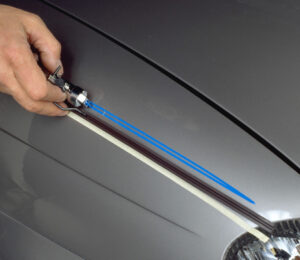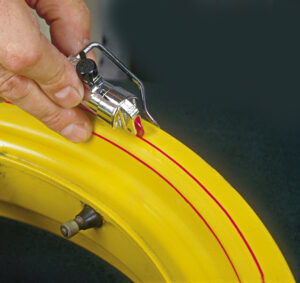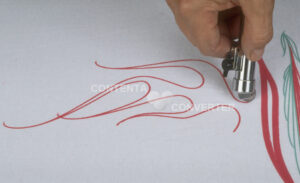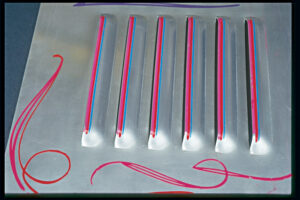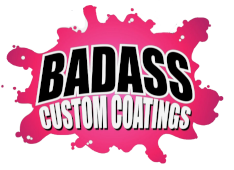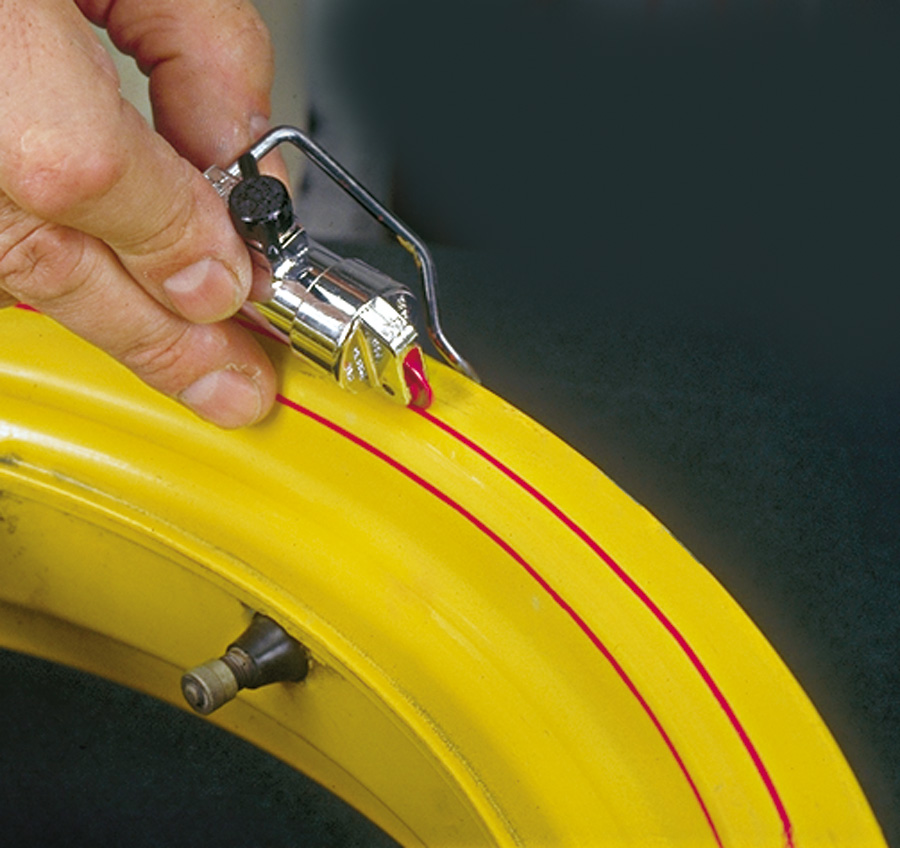PINSTRIPING GUIDE
The Beugler Striper makes pinstriping and detailed paint lining on any surface remarkably simple, and it’s easy to use. Your Beugler Striper comes complete with a variety of wheel heads enabling you to stripe in several widths, from extremely fine lines to clean broad strokes.
STANDARD LINE WIDTHS
#16 1/64” (.4 mm)
#25 1/32” (.8 mm)
#43 3/64” (1.3 mm)
#57 1/16” (1.7 mm)
#73 3/32” (2.3 mm)
#93 7/64” (2.8 mm)
#115 1/8” (3.2 mm)
see STRIPE SIZES/WHEEL HEADS
For complete details with photographs: Download the Beugler User’s Manual FREE!
Use most any creamy consistency paint to obtain excellent results on virtually any surface from metal to cloth, even glass and wood. Flat or curved, smooth and porous surfaces, the Beugler striping tool applies clean paint lines and gives you excellent results with very little practice.
The Beugler Striper uses a unique wheel head design that distributes paint evenly on any surface.
- The Beugler tool is safe and non-pressurized
- Is not gravity fed which enables paint to flow in any position.
- No tape is needed for clean edges.
- And The Beugler Striper eliminates stick-on vinyl tape and paint brushes.
The Beugler Striper’s precision design and machining allows for an even layer of paint to be applied without variance in thickness or width. The Beugler striping tool consists of a paint barrel and a friction fit wheel head. When rotated the wheel picks up and distributes paint evenly by way of precision serrations, regardless of speed of application.
THE TOOL’S PLUNGER PROVIDES A READY SUPPLY OF PAINT WITHOUT PRESSURIZING THE BARREL.
To load the Beugler striping tool remove the wheel head by firmly pulling it off. Pull the plunger back allowing space for your paint. Most paint can be used directly from the can if it has a creamy consistency. Once you have filled the tool with the appropriate amount of paint, replace the wheel head by pressing it firmly onto the paint barrel. Be sure to align the wheel head with the guide bar on top. Hold the tool vertically and gently expel the air in the barrel and lift the paint to the wheel by pressing the plunger upward until you see a small bead of paint at the wheel. Remember, the wheel rotates to pick up paint in its serrations. Wipe off any excess paint before striping. Now you’re ready to stripe. Using enough downward pressure for the wheel to roll, begin striping.
You’ll find the Beugler tool will stripe everything with ease. The Beugler tool should only be used with the wheel rotating in this direction. Before striping, prime the tool with a couple of short strokes, which coats the wheel with wet paint. Place the wheel down firmly and pull, rolling the stripe on your surface. With a twist of the wrist a curving, even line can easily be applied. The speed that you pull the tool or changes in the speed have no effect on the stripe size. Even shaking the tool will not produce a drip. Only when the wheel rotates on a surface will paint be distributed. If you tilt the tool from flat position to its edge you.will achieve a tapered line either straight or curved. Lifting at the end of this stroke produces a pointed tip. Holding the Beugler tool like a pen may limit control and versatility. The most common grip is much like a utility knife where fingers are to the side, opposite the thumb or with the index finger on top, much like a glass cutter. Keep your wrist loose for smooth curves. Holding the tool more vertically will allow for tighter turns. With the tool almost parallel to the surface, straight lines are easily achieved even without a straight edge.
HOLDING THE TOOL
Reversing the direction results in paint build up at the base of the wheel. If this should happen wipe clean. Always keep the wheel flat to the surface for an even line width.
The Beugler tool will stripe over a thousand feet on a single barrel full of paint, depending on the wheel size. However for extensive practicing or mural painting a squeeze bottle is handy for refilling. Experiment with your Beugler tool to explore all of the possibilities. 1) On a pad of paper practice some freehand straight lines. 2) Then try some tapers. 3) Tips are done by pulling a taper away from you. Then come back toward yourself, starting with a taper and pulling into a full width as you separate the lines. 4) Run curved or straight lines parallel to each other, starting and stopping with tips on each end. 5) Finally, do lots of nonstop figure 8’s starting large and working smaller. Try to keep the stripe width constant and your wrist loose. If there’s a secret to learning freehand striping, it’s simply to practice the five basics first, then combine them for your designs.
Flames:
To create flames repeat the pattern of curve, taper, tip, curve, taper, tip over and over again. Starting with a curve pulled away from you, ending with a taper, make a tip by pulling the tool back, from edge of wheel to wheel flat on the surface, and continue with a curve. Flames can be a dynamic graphic element as well as a great learning exercise. The weight, size and balance of The Beugler Striper allows for superior control and precise detail. By simply rotating the wrist or twisting your fingers you can obtain a variety of painting effects. One method for following a guide line or for outlining is to turn the tool around and hold it in a vertical position, pushing the tool away from you using the wheel or wheel head as a sight. Direction can be controlled by simply twisting the tool with your fingertips. Be sure to hold the tool in a vertical position to the surface to maintain line width. Guide lines can be helpful for accurate work. Use a “Stabilo” marking pencil to establish your guide line. There are two recommended techniques for following your guide line: First, hold the tool parallel to the surface and pull next to the guide line. Second, use the vertical grip and push on the line using the wheel as a sight.
GUIDE LINES
Try to keep the stripe width constant and your wrist loose. As you approach the starting point of your line, look ahead for a seamless match up. For a second line, use the shoulder, located next to the wheel as a sight to maintain an even space between the two lines. Push the tool forward with a steady motion, keeping the shoulder of the wheel head along side the edge of the first stripe. Using masking tape as a guide line is fast and particularly useful on large vehicles and non-ferrous surfaces. When using tape as a reference line, keep your eye on the space and maintain an even distance between the tape and the stripe. If you find that the space is increasing or decreasing make a gradual adjustment and the correction won’t be noticed. Your Beugler Striper comes with various adjustable guide arms that will help you effortlessly paint parallel to any existing edge. As you pull the striper, be sure to keep the guide touching the edge for a precise parallel line to that edge. Simply adjust the guide arm to the distance you want to stripe from the edge. A thumb screw located on top of the tool secures the guide when in position. Be sure to hold the tool parallel to the edge you’re following. Loosen the thumb screw and re-adjust and secure the guide arm for an additional parallel line. Wheels and rims are easily painted by rotating them while keeping the Beugler tool with guide in a set position. Masking tape at the beginning and end of the line help ensure a clean end to the line, or simply stop and lift the tool for a clean, rounded end. Or tilt the tool to one side or the other for a tapered end. To precisely determine the location of tapered or square endings, it is suggested that you use low profile tape at either an angle for tapered ends or right angle for square ends. Simply run the tool over the tape and gently lift tape from your surface while the paint is still wet. Masking tape can also be used to create a clean break in your striping work. A detailed connection can then be added.
TAPE AS A GUIDE LINE
Using masking tape as a guide line is fast and particularly useful on large vehicles and non-ferrous surfaces. When using tape as a reference line, keep your eye on the space and maintain an even distance between the tape and the stripe. If you find that the space is increasing or decreasing make a gradual adjustment and the correction won’t be noticed. Do not touch the tape with paint wheel!
USING GUIDE ARMS
Your Beugler Striper comes with various adjustable guide arms that will help you effortlessly paint parallel to any existing edge. As you pull the striper, be sure to keep the guide touching the edge for a precise parallel line to that edge. Simply adjust the guide arm to the distance you want to stripe from the edge. A thumb screw located on top of the tool secures the guide when in position. Be sure to hold the tool parallel to the edge you’re following. Loosen the thumb screw and re-adjust and secure the guide arm for an additional parallel line. Wheels and rims are easily painted by rotating them while keeping the Beugler tool with guide in a set position. Masking tape at the beginning and end of the line help ensure a clean end to the line, or simply stop and lift the tool for a clean, rounded end. Or tilt the tool to one side or the other for a tapered end. To precisely determine the location of tapered or square endings, it is suggested that you use low profile tape at either an angle for tapered ends or right angle for square ends. Simply run the tool over the tape and gently lift tape from your surface while the paint is still wet. Masking tape can also be used to create a clean break in your striping work. A detailed connection can then be added. Guide arms are designed to be used on either side of the tool.
For bolder line weights use one of the wide wheel heads. To avoid inconsistent lines that could occur by twisting the tool use your index finger on top and… Keep the Wheel Flat for Perfect Wide Striping! The double wheel head is also very useful. Like the wide wheel head, if the tool rocks to either side the wheels will not be in contact with the surface. To ensure consistent line thickness, keep the tool flat to the surface and use your index finger as shown to maintain wheel contact. The double wheel head is ideal for use where a standard single-color double stripe is called for. To keep the Beugler tool flat, let your little finger lightly slide along as you move across the surface with the index finger holding the wheel in contact with the surface. Again, a small piece of masking tape can ensure a perfect flat edge to the end of your line. Narrow masking tape is more suitable for a reference line when striping tight curves. With little effort you can shape your tape into any reference line… then follow the path with the Beugler tool. Remember to keep your body in the most comfortable position to avoid straining. The Beugler tool will execute a consistent line weight regardless of the speed at which you stripe, so relax and enjoy. For perfect striping on cars, trucks or any steel surface use Beugler’s flexible Magnetic Guide. This will guide your tool and assist you in painting flawless straight lines or long smooth curves.
Prior to striping a vehicle, make sure you have your:
- Beugler striping tool
- Lettering enamel paint
- Magnetic guide
- Masking tapes
- Clean- up rags or tissue
- Thinner
- Wax & grease remover.
Apply wax and grease remover liberally to a rag, and rub surface vigorously. Then follow with a clean cloth to eliminate any remaining solvent and dissolved wax from painted surface.
